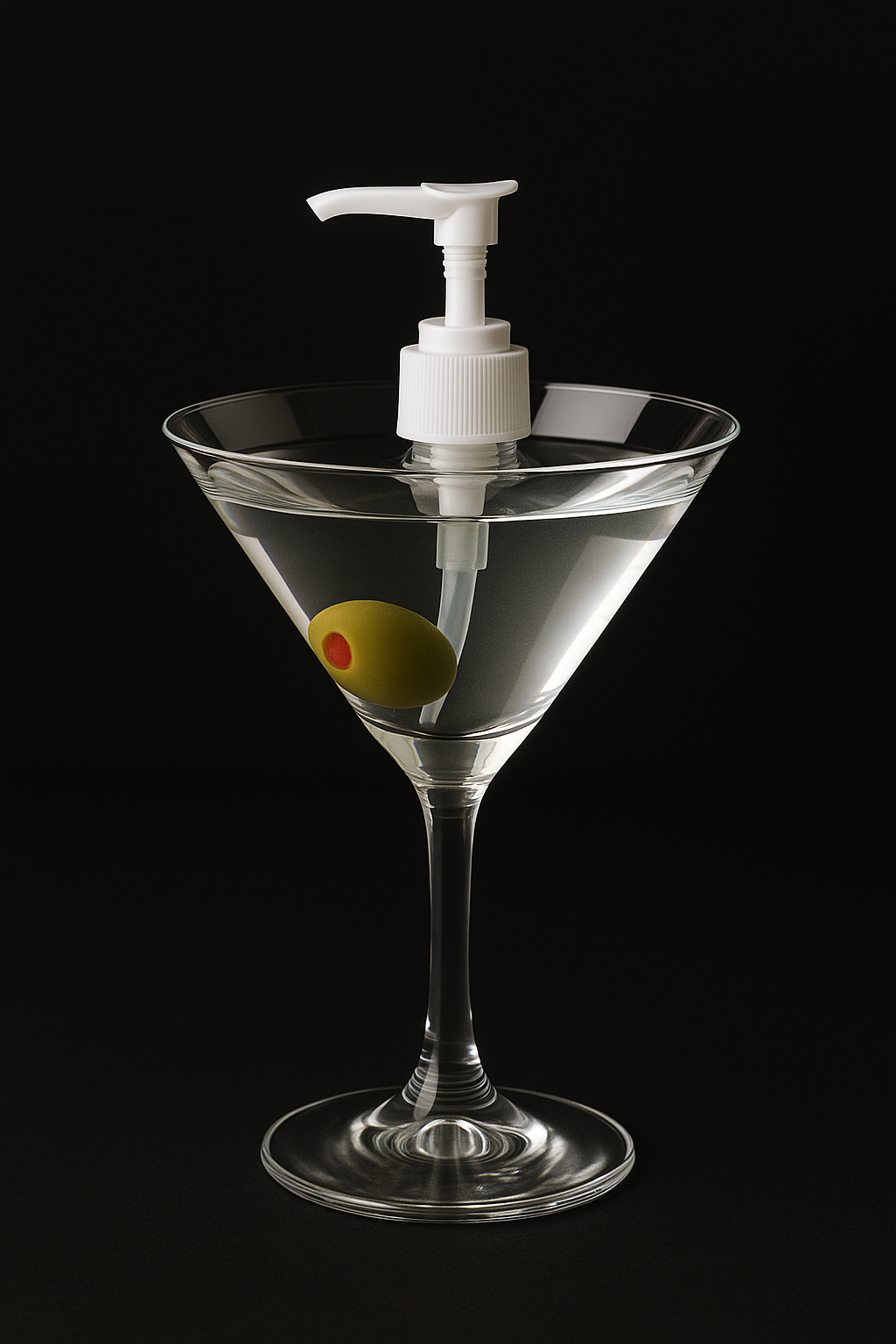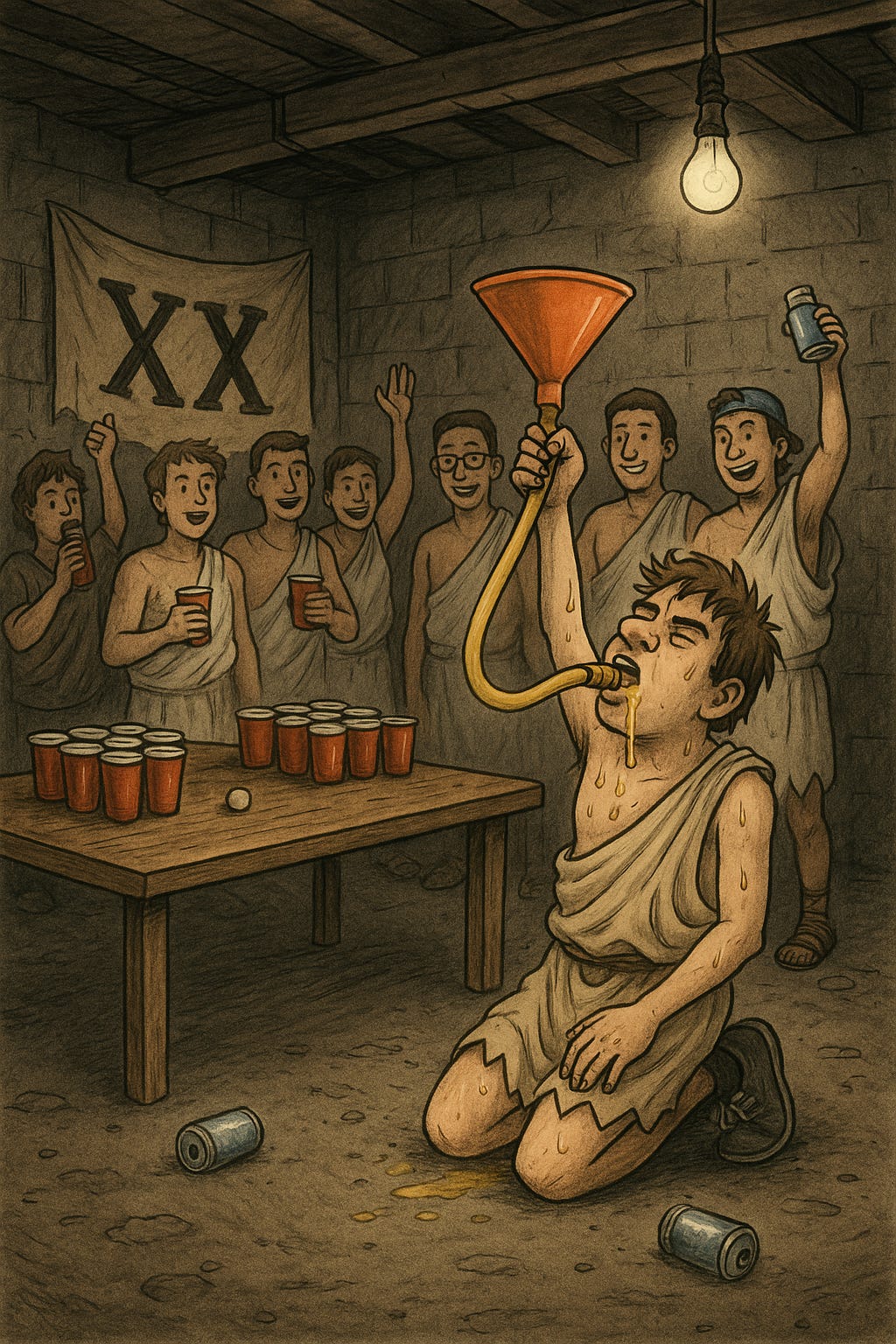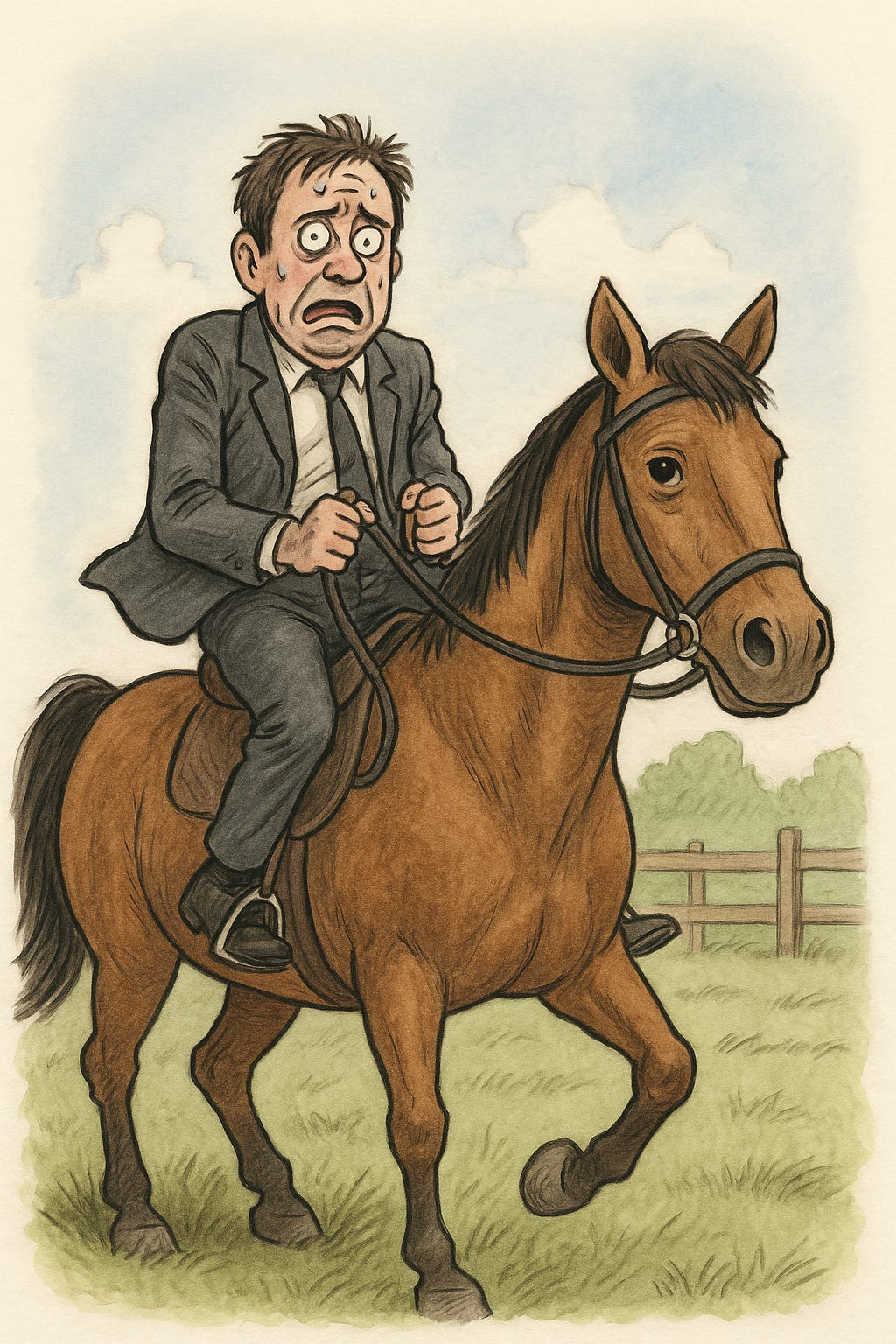Why quit drinking
The first of a three part series. Find part two here, and part three here.
Alcohol is a poisonous, addictive, expensive, sleep-disrupting social crutch which spreads like a contagion and dangerously deprives drinkers of self-control.
I. Poisonous
Alcohol kills living cells: it dissolves membranes, denatures proteins, and poisons microbes on contact. There’s a reason why what you do drink is only a small to minority percentage of actual alcohol; at full strength, it would burn your mouth, destroy your stomach lining, and kill you outright.
Figure 1. The difference between your hand sanitizer and your cocktail is water, flavorful additions to mask the original taste, and marketing.
So, we socialize at 7% to 40% alcohol and sanitize at 70% to 90% - the same toxin, different dilution. Doesn’t the dose do the damage? Sure - in the same way that jumping from the second floor instead of the tenth floor makes gravity safer. The World Health Organization says
“No level of alcohol consumption is safe for our health… Alcohol is a toxic, psychoactive, and dependence-producing substance and has been classified as a Group 1 carcinogen by the International Agency for Research on Cancer decades ago – this is the highest risk group, which also includes asbestos, radiation and tobacco. Alcohol causes at least seven types of cancer, including the most common cancer types, such as bowel cancer and female breast cancer… half of all alcohol-attributable cancers in the WHO European Region are caused by ‘light’ and ‘moderate’ alcohol consumption… This drinking pattern is responsible for the majority of alcohol-attributable breast cancers in women”
David Nutt, previously the “UK government chief drugs advisor” and a neuropsychopharmacologist (a title so long that it seems untranslated from German) writes in his book Drink? “if you want to maximize your life, the rule would be not to drink a drop. The same goes for if you want to maximize your health: don’t drink at all—because there are no health benefits to it.” He adds: “Alcohol use is one of the top five causes of disease and disability in almost all countries in Europe. In the UK, alcohol is now the leading cause of death in men between the ages of 16 and 54 years, accounting for over 20 per cent of the total.” The American Surgeon General has advised that alcohol “is the third leading preventable cause of cancer in America, after tobacco and obesity” - and note that alcohol can contribute to obesity. George Vaillant reports that “Alcoholism is involved in a quarter of all admissions to general hospitals.” A 2018 article in the prestigious medical journal the Lancet found that “Globally, alcohol use was the seventh leading risk factor for both deaths and [disability-adjusted life years] in 2016, accounting for 2.2%... of age-standardised female deaths and 6.8%... of age-standardized male deaths.” For those under 50, the leading alcohol-related causes of death included self-harm and road accidents, which we’ll revisit; but for those over 50, it’s cancer. Lancet concludes “The level of alcohol consumption that minimised harm across health outcomes was zero.”
To minimize the risk of dementia, Richard Restak, “a past president of the American Neuropsychiatric Association… advises his patients to quit alcohol by 70 at the latest. Over 65, he writes, you typically have fewer brain neurons than when you were younger, so why risk them? ‘Alcohol is a very, very weak neurotoxin – it’s not good for nerve cells.’” Nutt is blunter: “drinking causes brain damage. In fact, the leading preventable causes of dementia are head injury and the damage alcohol does to the brain. It’s thought at least one in five cases of dementia is probably due to alcohol.” Nutt reports that “in a 30 year study… which involved over 500 people having their brains scanned and their drinking histories taken, there were increased odds of hippocampal atrophy in those drinking up to 10 drinks weekly, and faster cognitive decline in those drinking up to five drinks weekly.” More broadly, alcohol dulls thinking and blunts memory; quitting means sharper focus and better decision-making. And then there’s the troublesome relationship between alcohol and depression. While the depressed drink for relief, alcohol is literally a central nervous system depressant - alcohol floods your brain with artificial dopamine for an hour, then strips it bare for days.
Alcohol also “lowers libido and increases the likelihood of impotence too”; the more it is consumed the more it chemically feminizes men; and it reduces fertility in both sexes. Nutt reveals that “Prolactin is the hormone that promotes milk production. And it’s been shown that levels are higher in heavy drinkers of both sexes… Men need low levels of prolactin for sperm production. But if levels rise, you can get breast growth and testosterone levels go down.” And, to think, men only fear beer belly! Nutt continues: “This is one reason men who drink heavily end up being feminized. Alcohol also lowers testosterone via other mechanisms; it increases levels of an enzyme that breaks it down and turns it into estrogen… And acetaldehyde (produced in the liver when alcohol is broken down) impairs the production of an enzyme that’s key for testosterone synthesis.” Meanwhile, “a review of studies of nearly 100,000 women showed that drinking at any level reduced fertility—13 percent (for any drinking), 11 percent (for light drinking: around one beer or a very small glass of wine a day), and 23 percent (for moderate-to-heavy drinking: more than a small glass of wine a day).”
Figure 2. A modern anti-fertility ritual
Alcohol accelerates the visible signs of aging, contributes to obesity, and destroys skin quality. The former paratrooper William Porter insists that “Every drink you consume erodes your fitness,” because of its effect on raising your heart rate, lowering heart rate variability, and causing “general lethargy,” not to mention hangovers. Because alcohol lowers your inhibitions and gives you empty calories, you drink more and eat more than you would otherwise have intended. If wine wastes workouts, don’t drink your gains away. Meanwhile, alcohol functions like a reverse Botox, every drink helping add lines to your face. Alcohol dehydrates skin into something drier, duller, less elastic (while disrupting rejuvenating sleep, more on that in a moment). Alcohol also dilates blood vessels, causing redness, puffiness, and in some people, flushing. The typical high school reunion reveals the toll.
But what about the evidence that moderate drinking is healthy? First, bear in mind that the global $1.5+ trillion alcohol industry has an extremely strong incentive to convince you to keep buying alcohol. In its heyday, the tobacco industry funded scientists who misattributed cancer to urban air, stress, and constitutional susceptibility while claiming the real benefits of mental focus, stress relief, weight control, and even ulcer protection. And governments, ‘accountable’ to politicians who rely on campaign contributions and guard local jobs, are not neutral - recall that the U.S. government once tried to classify ketchup as a vegetable for the purposes of calculating children’s nutrition in schools. Startlingly, the alcohol industry has even been directly involved in financing studies conducted on behalf of the government, gaining the latter’s ‘neutral’ imprimatur. I mentioned that Nutt was the “UK government chief drugs advisor”; officially, he “was fired in 2009 for saying government drugs policy wasn’t evidence based,” but “the real reason for my firing, I believe, was that I had the temerity to say on prime-time radio that alcohol was the most harmful drug in the UK… the link between drinking and disease isn’t pointed out to us by government or doctors nearly as clearly as smoking: there aren’t pictures of diseased livers or breast cancer tumors on the label of a bottle of Pinot Noir, for example.”
Figure 3. That was not Nutt’s only controversial statement: he also said that ecstasy was safer than horseback riding.
Second, as detailed already, multiple health organizations without funding from the alcohol industry have concluded that zero is healthiest. WHO: “there are no studies that would demonstrate that the potential beneficial effects of light and moderate drinking on cardiovascular diseases and type 2 diabetes outweigh the cancer risk associated with these same levels of alcohol consumption for individual consumers.” Recall that smoking helps you focus. A Canadian academic “analysis of decades of research” of “more than 100 studies of almost five million adults” found that “moderate drinking has no health benefits.” The New York Times summarizes the corrective: “Most of those studies [finding benefits] were observational, meaning they could identify links or associations but they could be misleading and did not prove cause and effect. Scientists said that the older studies failed to recognize that light and moderate drinkers had myriad other healthy habits and advantages, and that the abstainers used as a comparison group often included former drinkers who had given up alcohol after developing health problems.” In other words, the 'healthy moderate drinker' was healthy despite alcohol, not because of it. It's like upholding jaywalkers as leading healthy lives because they get in more steps.
Nutt concedes that “Evidence does suggest that drinking small amounts of red wine” - and only red wine, not any other type of alcohol - “might possibly be a little cardio-protective… But the optimal amount of alcohol to consume per week to get this protective effect is about equivalent to just 75 milliliters of 13.5 percent ABV wine (less than half a 5-ounce glass in a bar). Drink any more, and the effects become negative. When consumed in that volume (or lack of it), you’re really treating red wine more like having a shot of medicine rather than a recreational drink.” When I read that, I thought: an endorsement of communion?
What is most accurate (and obvious) is that moderate drinking is not as harmful as heavy drinking. What constitutes heavy drinking? The Wall Street Journal offers, “Regular drinking of two or more drinks, three or more times a week, shortens life expectancy by about seven years.” Nutt quantifies: “One microlife is 30 minutes off your life expectancy. If you are a 30-year-old man, you will lose one microlife by smoking two cigarettes, or each day of being 11 pounds overweight, or for every four standard drinks. But it gets worse if you drink more than that because of the exponential rise in alcohol harms.” Or, put another way, Nutt advises, “to stay below the acceptable food standard risk for cancer you should consume no more than 50 milligrams per day. This works out as 18 grams per year, that is, a maximum of two standard drinks a year!” As they’re legally required to whisper or put in small print, drink responsibly.
Nutt concludes: “If [alcohol] were discovered today, it would be illegal” and asks “Would you take a new drug if you were told it would increase your risk of cancer, dementia, heart disease, or that it shortened your life?” Admittedly, public health officials have an incentive to over-warn, overcommit to safetyism, and not account for non-health-related tradeoffs, which we will revisit. But consider this: you’re probably aware of (and lament) that we have an opioid crisis. Alcohol kills not only more Americans than opioids, but all illegal drugs combined. Alcohol also kills more Americans than guns or car accidents (though it contributes to its fair share of both). Every year, alcohol kills more Americans than were lost in the entire Vietnam War.
None of this is an endorsement of Prohibition, but it should give you pause for your own drinking. And you probably already to some extent recognize alcohol as a poison - watch how people react if a pregnant woman reaches for a glass of wine.




